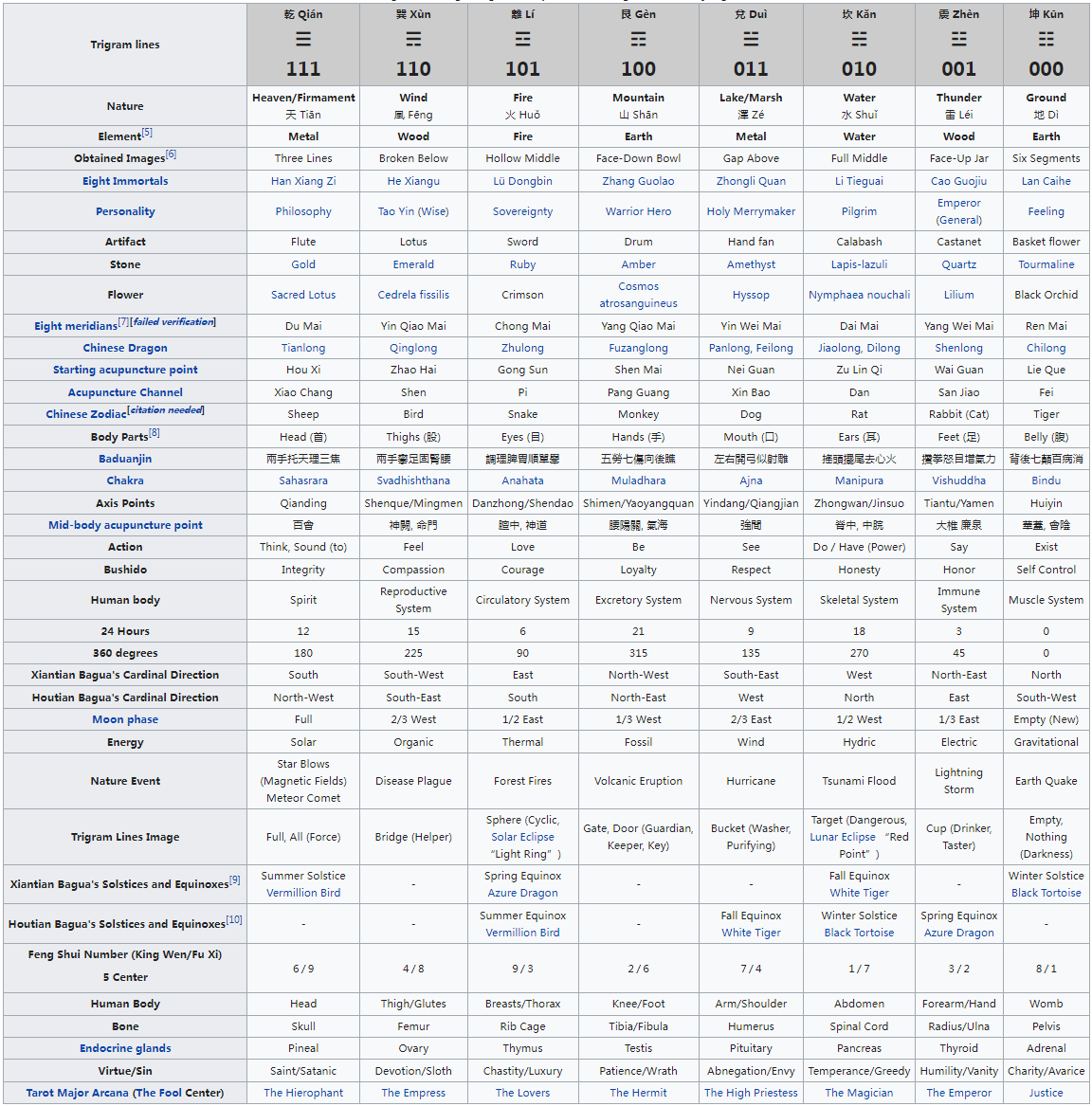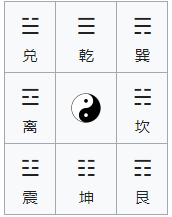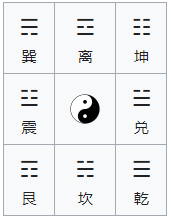if you’re new to feng shui and Bagua, it can be quite a bit to take in all at once, so we’ve put together this beginner’s guide to understanding Bagua and how it differs from other types of feng shui. In this guide, you’ll learn how the Bagua map differs from the Flying Star Map, how to create your own personal Bagua map, what different shapes of the bagua signify, and much more! You’ll have all the information you need to get started with your own personalized Bagua map in no time!
What is Bagua?
Components of Bagua
1.Yao
“Yao” in Chinese, it is “爻”, is the most basic symbol, which means interlacing, which is represented by odd pictures (“⚊” is called Yang Yao) or even pictures (“⚋” is called Yin Yao).
Yao has two types of yin and yang. Four images are added with one more line to form a gossip.
The lines are arranged from bottom to top. The meaning of the “three” lines symbolizes “heaven, man and earth” (the sky is above, the earth is below, and people are in it).
2. single hexagram (sutra hexagram)
A single hexagram (jing hexagram) can be formed by three Yaos.
Eight Trigrams means eight single trigrams (eight sutras).
| Chinese Version | English Version | ||||||
| 符号 | 卦名 | 自然象征 | symbol | Gua name | natural symbol | ||
| 1 | ☰ | 乾qián | 天 | 1 | ☰ | qián | Heaven |
| 2 | ☱ | 兑duì | 泽 | 2 | ☱ | duì | Lake |
| 3 | ☲ | 离lí | 火 | 3 | ☲ | lí | fire |
| 4 | ☳ | 震zhèn | 雷 | 4 | ☳ | zhèn | thunder |
| 5 | ☴ | 巽xùn | 风 | 5 | ☴ | xùn | wind |
| 6 | ☵ | 坎kǎn | 水 | 6 | ☵ | kǎn | water |
| 7 | ☶ | 艮gèn | 山 | 7 | ☶ | gèn | Mountain |
| 8 | ☷ | 坤kūn | 地 | 8 | ☷ | kūn | Ground |
Each hexagram represents a state or process.
3. Heavy hexagrams (different hexagrams)
Sixty-four hexagrams can be evolved through the eight trigrams. When two gossips are superimposed on each other (complex trigrams), they form eighty-eighty-sixty-four trigrams.
Sixty-four hexagrams, meaning sixty-four heavy hexagrams (sixty-four different hexagrams). That is, the eight “single hexagrams” (jing hexagrams) are intertwined with latitude and longitude to form sixty-four “heavy hexagrams” (different hexagrams).

Bāguà—The eight trigrams

Bagua used in Feng Shui
Bagua is one of the essential tools of Feng Shui. There are two different versions of the Bagua used in Feng Shui: those used in cemeteries are the Primal Bagua and those used in residences are called the Later Bagua.
The Xiantian Bagua (Primordial Bagua)

| 卦名 | 自然 | 季节 | 性情 | 家族 | 方位 | 意義 |
| Name | Nature | Season | Personality | Family | Direction | Meaning |
| 乾 Qián | 天 Sky (Heaven) | Summer | Creative | 父 Father | 南 South | 健 Expansive energy, the sky. For further information, see tiān. |
| 巽 Xùn | 風 Wind | Summer | Gentle | 長女 Eldest Daughter | 西南 Southwest | 入 Gentle penetration, flexibility. |
| 坎 Kǎn | 水 Water | Autumn | Abysmal | 中男 Middle Son | 西 West | 陷 Danger, rapid rivers, the abyss, the moon. |
| 艮 Gèn | 山 Mountain | Autumn | Still | 少男 Youngest Son | 西北 Northwest | 止 Stillness, immovability. |
| 坤 Kūn | 地 Earth | Winter | Receptive | 母 Mother | 北 North | 順 Receptive energy, that which yields. For further information, see dì. |
| 震 Zhèn | 雷 Thunder | Winter | Arousing | 長男 Eldest Son | 東北 Northeast | 動 Excitation, revolution, division. |
| 離 Lí | 火 Fire | Spring | Clinging | 中女 Middle Daughter | 東 East | 麗 Rapid movement, radiance, the sun. |
| 兌 Duì | 澤 Lake | Spring | Joyous | 少女 Youngest Daughter | 東南 Southeast | 悅 Joy, satisfaction, stagnation. |
Shao Yong, a scholar of the Song dynasty, that the four signs of the eight trigrams (orientation), eight-eights to generate 64 trigrams, this is the Fuxi Bagua, also known as the Manifested Bagua; some scholars believe that the eight trigrams should come from King Wen’s doctrine of Qian and Kun, he believes that the first heaven and earth, heaven and earth intersect and generate everything, the sky is dry, the earth is Kun, the other six trigrams are its children: Zhen for the long male, Kan for the male, Burgundy for the young male; Xun for the long female, leaving for the female, Tui for the young girl. This is the Eight Trigrams of the King of Wens, also known as the Eight Trigrams of the Later Heaven. Before Shao Yong, there was no distinction between the first and second Heavenly Bagua.
The Houtian Bagua(Manifested Bagua)

| 卦名 | 自然 | 季节 | 性情 | 家族 | 方位 | 意義 |
| Name | Nature | Season | Personality | Family | Direction | Meaning |
| 離 Li | 火 Fire | Summer | Clinging | 中女 Middle Daughter | 南 South | 麗 Pulsing motion, radiance, the luminaries. |
| 坤 Kun | 地 Earth | Summer | Receptive | 母 Mother | 西南 Southwest | 順 Receptive energy, that which yields. |
| 兌 Dui | 澤 Lake | Autumn | Joyous | 少女 Youngest Daughter | 西 West | 悅 Joy, satisfaction, stagnation. |
| 乾 Qian | 天 Heaven | Autumn | Creative | 父 Father | 西北 Northwest | 健 Expansive energy, the sky. |
| 坎 Kan | 水 Water | Winter | Abysmal | 中男 Middle Son | 北 North | 陷 Danger, rapid rivers, the abyss, the moon. |
| 艮 Gen | 山 Mountain | Winter | Still | 少男 Youngest Son | 東北 Northeast | 止 Stillness, immovability. |
| 震 Zhen | 雷 Thunder | Spring | Arousing | 長男 Eldest Son | 東 East | 動 Excitation, revolution, division. |
| 巽 Xun | 風 Wind | Spring | Gentle | 長女 Eldest Daughter | 東南 Southeast | 入 Gentle penetration, flexibility. |
The eight trigrams of the Later Heaven have a one-to-one relationship with the southeast and northwest directions: Zhen, Li, Tui and Kan represent due east, south, west and north respectively, while the remaining four trigrams represent the southeast, southwest, northwest and northeast corners. The diagram on the right also reflects the traditional way of making maps in ancient China.
Front south, back north (sitting north facing south), left east, right west. This orientation is exactly one hundred and eighty degrees different from the direction of the modern maps imported from the West, where north is the upper part of the map. (The development of China’s historical boundaries up to ancient times: from north to south, from the Yellow and Huai plains to the Yangtze river basin, may explain the idea of the ancients making maps.)
Why are the orientations of the Pre-ternatural Bagua different from the Post-ternatural Bagua? Some people believe that the Precessional Bagua reflects the view of the world before it was created, while the Postcessional Bagua is the opposite. Others believe that the first and second trigrams represent the concepts of three-dimensional vertical space and flat time respectively (similar to the dimensions in Western studies), as in the Qing dynasty’s Zhang Chao’s “Shadow of a Dream”, which reads: “The first trigrams are also seen vertically; the second trigrams are also seen horizontally”.
Bagua Map
The Bagua Map is a tool used in modern Feng Shui to map out a room or location and to see how the different sections correspond to different aspects of life. These factors affect the recipient’s fame, relationships, marriage, children, creativity, travel, occupation, inner knowledge, family relationships, health, and wealth.
The Bagua Map is intended to be used in the land, home, office or desk to identify areas lacking in good chi and to show negative or missing spaces in the life or environment that may need to be corrected or enhanced.